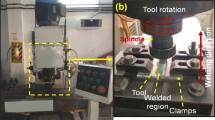Abstract
This study presents a novel method using a disk-like sample to assess the workability of metal during the cross wedge rolling (CWR) process. Using this method, we can quantitatively evaluate the moment destruction which occurs at the center of the sample during CWR. In this study, 45 steel was selected to demonstrate the proposed method. Firstly, we designed a model for the tools and sample, conducted finite element simulations to analyze the distribution regulations of metal flow, stress, and strain, and evaluated the relationship between the damage and moving distance of the tool during the forming process. Then, we obtained the optimal deformation temperature range, rolling speed, and geometry parameters for the tool. Finally, experiments were conducted from 20 °C to 1 200 °C to verify the accuracy of the developed model. It was demonstrated that the model was significantly accurate in accessing the workability of 45 steel in the CWR process. The proposed method could be generalized to investigate the CWR process for other materials, such as aluminum alloys, superalloys, titanium alloys, etc.












Similar content being viewed by others
References
Pater Z (1998) A study of cross wedge rolling process. J Mater Process Tech 80(1):370–375
Shu XD (2014) Cross wedge rolling theory and forming technology. Science Press, Beijing, pp 1–10
Hu ZH (2004) Technology and simulation of part rolling by cross wedge rolling. Metallurgical Industry Press, Beijing
Gronostajski Z, Pater Z, Madej L et al (2019) Recent development trends in metal forming. Arch Civ Mech Eng 19(3):898–941
Hu ZH, Wang BY, Zheng ZH (2018) Research and industrialization of near-net rolling technology used in shaft parts. Front Mech Eng-Prc 13(1):17–24
Zhou X, Shao Z, Pruncu CI et al (2020) A study on central crack formation in cross wedge rolling. J Mater Process Tech 279:116549
Pater Z (2014) 3.10—Cross-wedge rolling. In: Hashmi S, Batalha GF, Van Tyne CJ et al (eds) Comprehensive materials processing. Elsevier, Oxford, pp 211–279
Ghiotti A, Fanini S, Bruschi S et al (2009) Modelling of the Mannesmann effect. Cirp Ann-Manuf Techn 58(1):255–258
Wojcik L, Pater Z, Bulzak T et al (2020) Physical modeling of cross wedge rolling limitations. Materials 13(4):867
Pater Z, Tomczak J, Bulzak T (2019) Cavity formation in cross-wedge rolling processes. J Iron Steel Res Int 26(1):1–10
Astapchik SA, Kozhevnikova GV (2014) A study of metal plasticity of billets processed by cross-wedge rolling. News Natl Acad Sci Belarus 3:31–36
Pater Z, Tomczak J, Bulzak T et al (2020) Rotary compression in tool cavity—a new ductile fracture calibration test. Int J Adv Manuf Tech 106(9/10):4437–4449
Dong YM, Tagavi KA, Lovell MR et al (2000) Analysis of stress in cross wedge rolling with application to failure. Int J Mech Sci 42(7):1233–1253
Pater Z, Tomczak J, Bulzak T et al (2019) Prediction of crack formation for cross wedge rolling of harrow tooth preform. Materials 12(14):2287–2295
Pater Z, Tomczak J, Bulzak T et al (2019) Determination of the critical value of damage in a channel-die rotational compression test. Int J Mater Form 13:993–1002
Bulzak T, Pater Z, Tomczak J et al (2019) A rotary compression test for determining the critical value of the Cockcroft–Latham criterion for R260 steel. Int J Damage Mech 29(6):874–886
Huo YM, Lin JG, Bai Q et al (2017) Prediction of microstructure and ductile damage of a high-speed railway axle steel during cross wedge rolling. J Mater Process Tech 239:359–369
Mirahmadi SJ, Hamedi M, Ajami S (2014) Investigating the effects of cross wedge rolling tool parameters on formability of NimonicA (R) 80A and NimonicA (R) 115 superalloys. Int J Adv Manuf Tech 74(5/8):995–1004
Pater Z, Tomczak J, Bulzak T (2020) Establishment of a new hybrid fracture criterion for cross wedge rolling. Int J Mech Sci 167:105274. https://doi.org/10.1016/j.ijmecsci.2019.105274
Cockcroft MG, Latham DJ (1968) Ductility and the workability of metals. J Inst Met 96:33–39
Zhou J, Yu YY, Zeng Q (2014) Analysis and experimental studies of internal voids in multi-wedge cross wedge rolling stepped shaft. Int J Adv Manuf Tech 72(9/12):1559–1566
Qiu P, Lyu ZQ, Wang B et al (2012) Study on cross wedge rolling processes of middle carbon steels and microstructure and properties of rolled pieces. J Yanshan Univers 36:210–214
Yang CP, Dong HB, Hu ZH (2018) Micro-mechanism of central damage formation during cross wedge rolling. J Mater Process Tech 252:322–332
Pater Z, Tomczak J, Bulzak T et al (2020) Assessment of ductile fracture criteria with respect to their application in the modeling of cross wedge rolling. J Mater Process Tech 278:116501. https://doi.org/10.1016/j.jmatprotec.2019.116501
Sukhorukov SI (2008) Estimation of the used plasticity resource during cross wedge rolling. Proc Mater Press 1(19):39–44
Acknowledgements
This work was financially supported by the Sino-Belarus Inter-Governmental S&T Cooperation project (Grant No. CB0209) and the National Key R&D Plan (Grant No. SQ2018YFE011170), the Technical Innovation Program of Liaoning Province (Grant No. 2020JH6/10500018).
Author information
Authors and Affiliations
Corresponding author
Rights and permissions
About this article
Cite this article
Cheng, M., Shi, MJ., Vladimir, P. et al. Novel evaluation method for metal workability during cross wedge rolling process. Adv. Manuf. 9, 473–481 (2021). https://doi.org/10.1007/s40436-020-00344-9
Received:
Revised:
Accepted:
Published:
Issue Date:
DOI: https://doi.org/10.1007/s40436-020-00344-9




